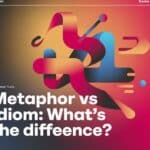Every time you are taken to a room or a hall, you would be left amazed at the wonderful painting done using words. Both of these add the same colors in the version of painting; however, they do it in a different way.
Understanding such things can change one’s writing radically. Let’s study the definitions, differences, and usage of both.
Introduction
Simile vs. Metaphor: Definitions, Differences, and Usage
Simile and Metaphor: Definitions, Types, and Usage. They have some of the most effective powers of language, but different approaches in wielding their meanings.
They do draw comparisons; however, in different ways, enriches our expression and understanding. Let’s figure out their definitions along with structures and effective use in writing.
Must read: Contractor or Contracter: Which Spelling is Correct?
Definitions and Structures
What is a Simile?
It means that two dissimilar objects are compared through the words “like” or “as.” For example, “Her smile was as bright as the sun” directly compares the brightness of her smile with the sun. This direct comparison helps put that image into the reader’s mind.
What is a Metaphor?
A metaphor makes a direct comparison without using “like” or “as.” Such expressions are direct in the conviction that one thing is another: “Time is a thief.” In this sense, the comparison subtly suggests that time steals moments from us, thus deepening the meaning of time.
How are Similes Structured?
Similes typically follow the structure: “X is like Y” or “X is as Y as Z”. For example, “Her hair is like silk” or “He is as brave as a lion.” This structure makes the comparison clear and easily understood.
How are Metaphors Structured?
Metaphors, it seems, tend to be constructed in the “X is Y” format. As for an instance, it can be said as “The world’s a stage.” The stage is here directly equated to the world; the evocation compels the reader to think into the similarities between the two.
Characteristics of a Simile
Explicit use of “like” or “as” to make a comparison marks a simile. It is direct and usually makes things more colorful or vivid-relation of things. Example: “Her laugh was like music to his ears”.
Characteristics of a Metaphor
Metaphor is indirect, reveals not that one thing is another. These usually charge a meaning and add complexity to writing. For example, “He is a star shining in the team” suggests he is unique but does not mean he is actually a star.
Etymology
Etymology of Simile
The term simile comes from the Latin word “simile,” which means “like” or “indicate similarity.” This is indicative of its function in the language, which is essentially to compare two very opposite things, using “like” or “as.”
Etymology of Metaphor
“Metaphor” comes from the Greek word “metaphora.” It means “a transfer,” or “a carrying over.” It imparts meaning especially in metaphor transfer from one concept to another so that language can be enriched with such profound significance.
Comparison and Differences
Simile vs. Metaphor
While comparing different things between similes and metaphors, the big difference is actually in the structure. It isn’t a comparison “like” or “as,” but the word makes similes while metaphors become entirely direct comparison without these two words.
Difference Between Simile and Metaphor
Similes and metaphors, while helpful in comparison, are similar in that similes openly make the comparison, invite understanding, while the metaphor does so implicitly, thus allowing more interpretative emphasis to remain in the hands of the reader or auditor. For example, simile says, “Her eyes were like stars,” while metaphor states, “Her eyes were stars.”
What Are the Similarities Between Simile and Metaphor?
Both simile and metaphor have the effect of comparison in describing two distinct entities, thereby embellishing the description and rendering it deeper in meaning. Both are expressive constructs that stretch ordinary lexical meaning.
You will like: Add vs Ad: Clarifying Their Meanings and Uses
What Are the Differences Between Simile and Metaphor?
The major difference is in the construct being used and in how it makes the comparison.Similes are explicitly comparative via one of the words “like” or “as”; metaphors carry out an implicit comparison by saying that one thing is another.
Simile and Metaphor: The Similarities
This is what both types of comparisons, similes and metaphors, have in common because they both make language richer and help each communicate feelings and create sharp images while enriching writing.
Structure of Comparison
Similes convey exactly the comparison with “like” or “as,” and metaphors yield that comparison implicitly-to one thing being another thing.
Degree of Comparison
Since they are more straightforward, metaphors often have a stronger effect, while similes may come across as softer or more tentative in their comparisons.
Clarity of Connection
Similes provide a clear connection between the two compared items, making them easily understandable. Metaphors, however, may require more interpretation to grasp the intended meaning.
Tone and Impact
One may think of metaphors as attributing solemnity, joy, or grandeur to one’s writing, while similes are generally held to be clear and simple.
Usage in Writing
When to Use a Simile and a Metaphor
Similes describe things that are directly comparable in a very simple way, thereby giving concrete definitions to the things described. In contrast, metaphors are used when some deeper or more abstract connection is needed between the two things considered.
Use in Writing
Both similes and metaphors serve useful purposes in writing. They serve to bring color to expressions. The metaphor creates praise and richness to writing.
Flexibility in Expression
Though a little more flexible in expression and subject to layers of meaning, metaphors could be called more creative. Similes would seem more straight-oriented with less flexibility.
Imagery and Visualization
One of the things that make similes effective for many readers is that they quickly create vivid images in people’s minds. Metaphors, on the other hand, conjure pictures that are generally more complex or have a finer point.
Use in Poetry vs. Prose
Both similes and metaphors are used in poetry and prose. However, metaphor in poetry is so abundant that it means whatever it says, sometimes with a few words.
When to Use Simile vs. Metaphor Effectively
Simile shows a plain, easy-to-undertstand relationship: it’s like,… If you want to express a more symbolic meaning, go for a metaphor.
Common Mistakes While Using Similes and Metaphors
Too many similes and metaphors in a line makes writing appear complicated or forced. Choose your comparisons and use them only to add meaning to your writing.
When to Avoid Similes
Do not use similes that sound stale or do not add anything to your writing. Such similes usually make your writing look unoriginal.
Why is There Confusion?
The comparison of simile and metaphor usually confuses because both make comparisons. But if these two are understood from their structural differences, it can easily clarify the shapes they take in language.
Examples
Simile vs. Metaphor Examples
Simile would say; He fought like a lion, and clearly comparing him to a lion is by using the word “like.” A metaphor would have read; “He was a lion in battle,” clearly stating the comparison without any intention to signal it. Both will paint a visual picture but very differently.
Examples of Simile in Literature
In To Kill a Mockingbird, one says: “She looked and smelled like a peppermint drop.” This gives a use of “like” to make this description colorful and relatable, enabling readers to visualize the character clearly.
Examples of Metaphor in Literature
This metaphor, which induces the world into a stage, encapsulates the broader idea that life is performed as opposed to indicating that everyone is directed as such.This phrase adds weight and depth to the theme of the play.
What Are Examples of Metaphors and Similes?
Life is like a box of chocolates, a saying from the movie Forrest Gump. It displays some unpredictability by using “like”.
Time is a thief, hence not literally stealing time but implying that it steals moments away. So, these two clearly show and highlight how both factors improve language: by linking abstract ideas to very familiar images.
You will like: Base or Bass: Which Word to Use and Why?
FAQ’S
What’s the main difference between a simile and a metaphor?
A simile uses words like “like” or “as” to compare, while a metaphor makes a direct comparison without those words.
Can similes and metaphors be used interchangeably?
Not always. Similes are clearer and more literal, while metaphors are stronger but more interpretive. Use depends on tone and context.
Why do writers use metaphors more in poetry?
Metaphors often carry layered meanings, ideal for poetic expression and emotional depth, making them popular in literature and verse.
Are similes easier to understand than metaphors?
Yes, typically. Because similes signal comparison directly, they’re more accessible, especially for younger readers or casual audiences.
Can a sentence contain both a simile and a metaphor?
Yes, but use caution. Mixing both can confuse the reader unless done skillfully. Clarity and flow should always come first.
Conclusion
Simile versus metaphor: understanding the definitions, differences, and functions is vital for expressive language mastery. Similes use “like” or “as” for comparisons, whereas metaphors directly compare and draw deeper symbolism with a less set and defined reference.
Both enrich writing with engaging imagery and emotional depth. The choice really lies in the way the tonality works, the clarity held by a particular figure, and the aims you set out to achieve in that communication.
Be it poetry or prose, if carefully done, one will be able to give a stride to the conversation. Use them to articulate charm and to assist in cementing the clarity of ideas and adding creativity.

Joulia, a seasoned wordsmith and grammar enthusiast, brings over a decade of blogging expertise to Grammar Tune. With a keen eye for linguistic precision and a passion for making complex grammar concepts accessible, he has helped thousands of readers enhance their writing skills. His engaging teaching style and practical approach to language learning have made him a trusted voice in the online grammar community.







